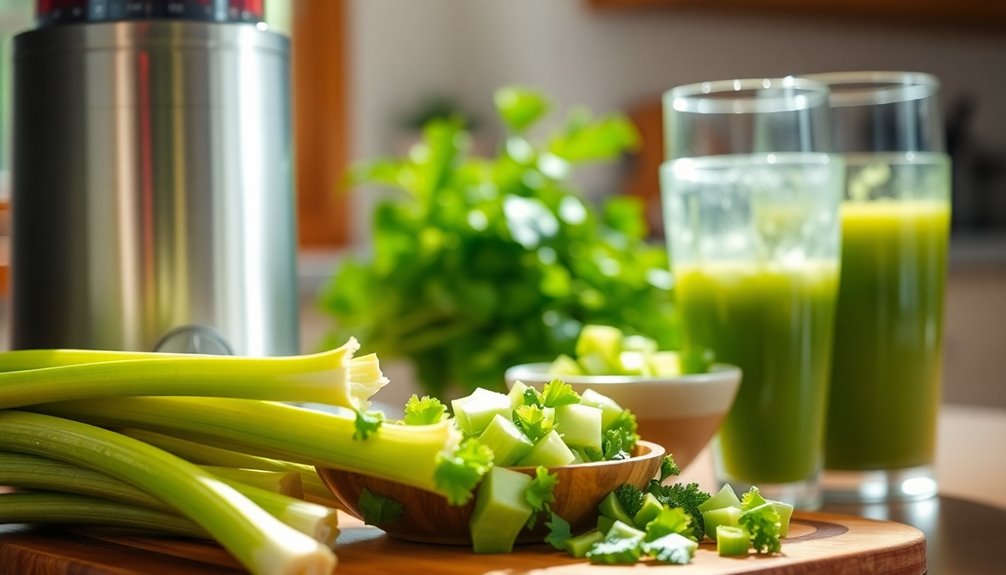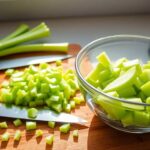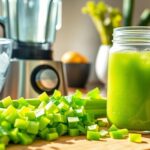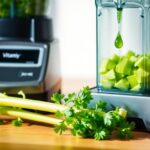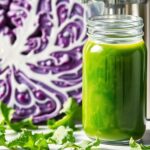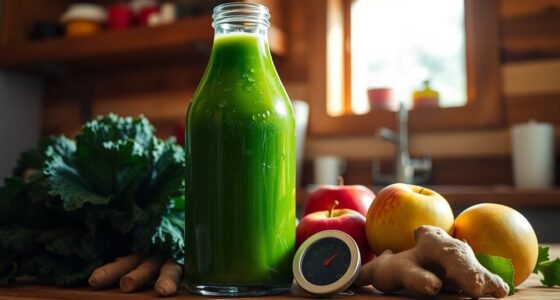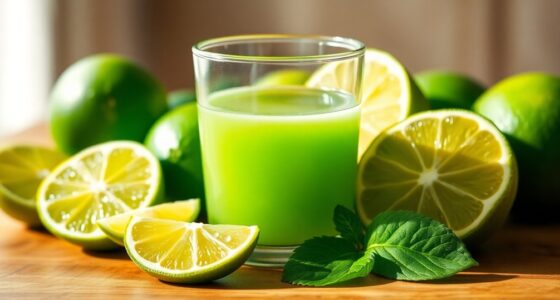To make celery juice with a Nutribullet, chop a whole head of fresh celery into manageable pieces. Blend one-third of the celery until it reaches a mushy consistency. Pour the mixture through a metal strainer over a jug to extract juice. You'll yield about a quarter to half a pint. Enjoy your juice first thing in the morning for best results. Want more tips on maximizing your juice experience? Stick around for more!
Key Takeaways
- Chop a whole head of fresh celery into small pieces suitable for the Nutribullet, using about one-third at a time for blending.
- Blend the chopped celery for around five seconds until it reaches a mushy pea consistency, shaking the Nutribullet if necessary.
- Set up a metal strainer over a jug and pour the blended celery gradually, allowing juice to extract without overloading the strainer.
- Expect to yield between a quarter pint to half a pint of juice, and decide whether to discard or save the pulp for other uses.
- Drink the celery juice first thing in the morning on an empty stomach for optimal nutrient absorption and health benefits.
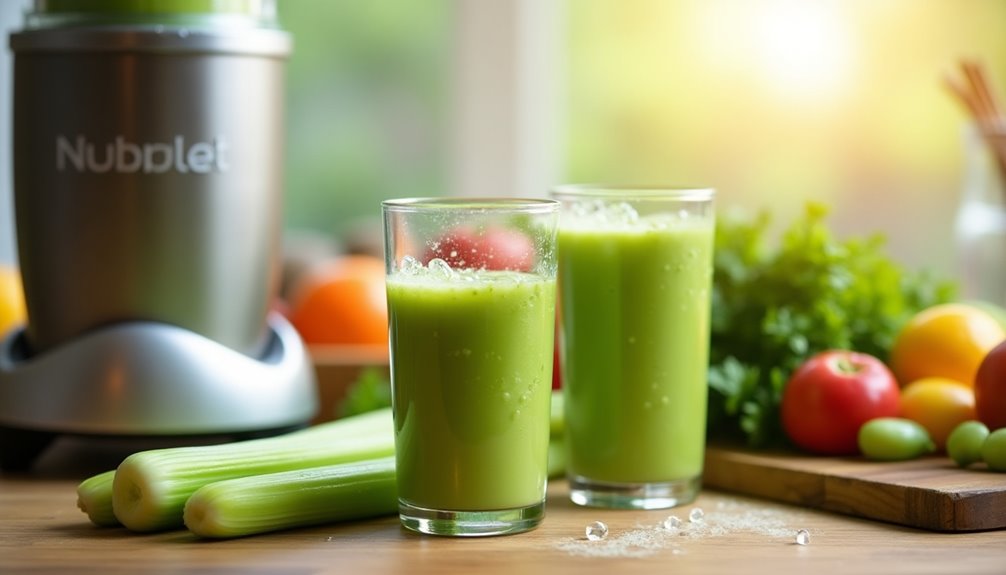
Making celery juice with a Nutribullet is a simple process that packs a powerful health punch. If you're looking to jumpstart your day, this vibrant green juice can be the perfect addition to your morning routine. It's packed with nutrients and drinking it first thing in the morning on an empty stomach enhances its benefits. You'll want to make sure you get it right, so let's dive into the steps.
First thing, grab a whole head of fresh celery, including the leaves. The leaves are often overlooked, but they contribute nutrients and flavor to your juice. Start by chopping the celery into manageable pieces. You don't need to worry about making them perfect; just ensure they're small enough to fit into your Nutribullet.
Once you’ve chopped about one-third of the head, place it into the Nutribullet without adding any water. The beauty of celery juice is that it’s naturally hydrating, so you won’t need to dilute it. Blend the celery until it reaches a smooth consistency, then strain the mixture if you prefer a thinner juice. Celery juice is not only refreshing, but it also packs numerous health benefits. Many people are curious about how celery juice affects blood pressure, as some studies suggest it may help in regulating and lowering high blood pressure.
Next, blend the celery for around five seconds. You want to break it down into smaller bits before adding more. After the first blend, toss in another third of the chopped celery and blend again. Keep blending until the mixture reaches a mushy pea consistency. This texture is crucial because it allows for better extraction of the juice in the next step.
If you're having trouble getting it to blend, you can give it a little shake to help the celery settle into the blades.
Once you’ve achieved the right consistency, it’s time to strain the juice. Set up a metal strainer or a strainer sock over a jug. Pour the blended celery gradually in thirds into the strainer. This method helps to extract as much juice as possible without overloading the strainer. As the juice drips into the jug, you can use a spatula or the back of a spoon to gently press the pulp to extract even more liquid. If you’re curious about how to enhance celery juice flavor, consider adding a splash of lemon juice or a hint of ginger for a refreshing twist. Once you’ve collected the juice, you can enjoy it as is or experiment with various ingredients to find your perfect blend.
Be patient and let it work its magic; you should yield between a quarter pint to half a pint of vibrant green juice after straining. You can choose to discard the pulp or save it for another use, like adding it to smoothies or soups.
When your celery juice is ready, it's time to enjoy it. Remember, the best time to drink it's first thing in the morning. Drinking it on an empty stomach maximizes the absorption of its nutrients and sets a healthy tone for your day.
You'll likely appreciate the refreshing taste and the benefits it brings to your body.
Frequently Asked Questions
Can You Use a Nutribullet to Juice Celery?
Yes, you can use a Nutribullet to juice celery. Just chop the celery into smaller pieces and blend them in batches for a smooth consistency.
Make sure you add the celery in thirds to get the best results. After blending, strain the mixture through a metal strainer to separate the juice from the pulp.
You'll find this method's not only cost-effective but also easy to clean up compared to traditional juicers.
Can You Use Nutribullet for Juicing?
Yes, you can use a Nutribullet for juicing!
It's designed to blend fruits and vegetables smoothly, making it perfect for creating juice. You just chop your produce, blend it without adding water, and then strain the mixture to separate the juice from the pulp.
The Nutribullet is compact, easy to clean, and versatile, offering a similar consistency to traditional juicers while being more affordable.
You'll love how simple it makes juicing!
Is Blending Celery as Good as Juicing?
Imagine vibrant green celery whirling in a blender, transforming into a thick, nutrient-packed elixir.
Blending celery is just as good as juicing, if not better, since you're keeping all that fiber and nutrients intact. You get a satisfying texture that fills you up, making it a perfect snack or meal replacement.
Plus, the Nutribullet makes it easy to blend and customize, allowing you to enjoy a healthier, more versatile option.
Is It Okay to Drink Celery Juice Every Day?
Yes, it's okay to drink celery juice every day!
You'll enjoy numerous health benefits, like improved hydration and digestive health, thanks to its high water and fiber content.
Plus, the vitamins and antioxidants in celery can support your immune function and skin health.
Just make sure you balance it with a varied diet to get a comprehensive range of nutrients.
Moderation is key, so listen to your body and enjoy!
Conclusion
Now that you know how to make celery juice with your Nutribullet, you're ready to enjoy this refreshing drink packed with nutrients. Remember, "An apple a day keeps the doctor away," but celery juice can be just as beneficial! By incorporating this green powerhouse into your routine, you'll boost your hydration and health. So, grab your Nutribullet, whip up that juice, and toast to a healthier you! Cheers to your wellness journey!
Cindy thoroughly researches juicing trends, techniques, and recipes to provide readers with practical advice and inspiration. Her writing style is accessible, engaging, and designed to make complex concepts easy to understand. Cindy’s dedication to promoting the advantages of juicing shines through her work, empowering readers to make positive changes in their lives through the simple act of juicing.

